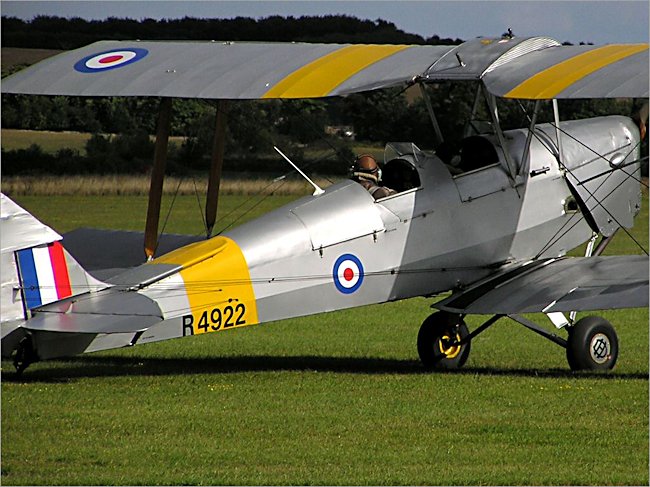de Havilland DH82 Tiger Moth Trainer
In the early 1930's Britain's Royal Air Force (RAF) announced that it was in the market for a new basic trainer aircraft. After some stiff competition the de Havilland DH82 Tiger Moth, developed from the D.H. 60M Gipsy Moth emerged as the clear winner. About 8,700 Tiger Moths were manufactured in Britain and elsewhere in the world under license.
About 4200 went into service with the Royal Air Force just in time to train thousands of pilots for World War II Battle of Britain and Overlord service. The Tiger Moth continued to serve the post-war RAF until 1951. The Tiger Moth had a maximum Speed of 107 mph with a cruising Speed: 90 mph. It only had a ceiling of 14,600 ft and a range of 275 miles. As a trainer it did not have any guns. There are over 250 still airworthy

Geoffery de Havilland trained as an engineer in 1900 in the British Midlands but later in 1906 he moved downs south to London and worked in the design office of the Motor Omnibus Company in Walthamstow. In 1908 he caught the aero plane heavier than air craze. He learned how to fly and esigned his own aero engine. He them built two very early aircraft to experiment with. They were so good that he was able to sell his second aircraft to the Army Balloon Factory at Farnborough in 1911. Geoffery de Havilland joined the Royal Flying Corps Special Reserve and worked as a test pilot at the Army Balloon Factory until June 1914. He then went to work for AIRCO Aircraft Manufacturing Co Ltd just before World War one. He helped design and produce a number of bombers, fighters and trainers that were used throughout the war. BSA took over AIRCO in 1919 but De Havilland bought out the Aviation part of the company and set up his own Aircraft firm known as the de Havilland Aircraft Company
The post war success of De Havillands DH9A medium bomber followed by the famous Gypsy Moth and later the world famous DH82 Tiger Moth meant that the company got off to a successful start. De Havilland made a number of Civilian transport aircraft and racing machines like the Comet. One notable triumph was the four engined long range elegant Albatross airliner that was made of wood with a stressed skin construction. During the second world war the De Havilland produced that legend of an aircraft the twin engined Mosquito fighter pathfinder bomber. The last wartime design was the twin boom jet engined De Havilland Vampire. After the war De Havilland resumed production of passenger airliners like the Dove and the De Havilland Comet. In 1952 the later was the first ever fare paying jet engined passenger plane to enter service. The De Havilland Company was absorbed by the Hawker Siddeley Group in 1960. In 1977 Hawker Siddeley Ltd was nationalized and became part of British Aerospace (BAE) group. Sir Geoffrey de Havilland carried on working for the company until his death at the age of 82. A brilliant man.
Tiger Moth books


Tweet